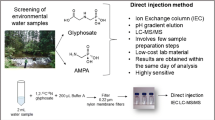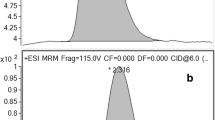Abstract
Polyacrylamides are polymers used in many fields and represent the main source of release of the highly toxic acrylamide in the environment. In this work, a simple, rapid, and sensitive analytical method was developed with HPLC/MS/MS and direct injection for acrylamide analysis in water and adsorption samples. AFNOR standards NF T90-210 and NF T90-220 were used for the analytical method validation and uncertainty estimation. Limit of quantification (LOQ) for acrylamide was 1 μg/L, and accuracy was checked at three acrylamide levels (1, 6, and 10 μg/L). Uncertainties were estimated at 34.2, 22, and 12.4 % for acrylamide concentrations at LOQ, 6 μg/L, and 10 μg/L, respectively. Acrylamide adsorption on clays (kaolinite, illite) and sludge was then studied as a function of pH, time, and acrylamide concentrations. Acrylamide adsorption on kaolinite, illite, and sludge was found to be very weak since adsorption percentages were inferior to 10 %, whatever the pH value and the initial acrylamide concentration. The low affinity of acrylamide for clays and sludge is likely due to its hydrophilic property, small size, and charge neutrality.






Similar content being viewed by others
References
AFNOR NF T90-210 (2009) Water quality—protocol for the estimation of the uncertainty associated to analysis result for physico-chemical analysis method, La Plaine Saint-Denis, pp 1–74
AFNOR NF T90-220 (2003) Water quality—protocol for the initial method performance assessment in a laboratory la Plaine Saint-Denis, pp. 1–43
Arrowood TJ (2008) Determining the fate and transport of the acrylamide monomer (AMD) in soil and groundwater systems. University of Nevada, Las Vegas
Backe WJ, Yingling V, Johnson T (2014) The determination of acrylamide in environmental and drinking waters by large-volume injection—hydrophilic-interaction liquid chromatography and tandem mass spectrometry. J Chromatogr A 1334:72–78
Brown L, Bancroft KCC, Rhead MM (1980) Laboratory studies on the adsorption of acrylamide monomer by sludge, sediments, clays, peat and synthetic resins. Water Res 14:779–781
Campredon B (2013) Mecanisms and transfert of Arsenic in the confluence of Var and study of a remediation method in drinking water, University Nice Sophia Antipolis, Nice
Cavalli S, Polesello S, Saccani G (2004) Determination of acrylamide in drinking water by large-volume direct injection and ion-exclusion chromatography mass spectrometry. J Chromatogr A 1039:155–159
Chu S, Metcalfe CD (2007) Analysis of acrylamide in water using a coevaporation preparative step and isotope dilution liquid chromatography tandem mass spectrometry. Anal Chem 79:5093–5096
CNRS (2008) Classification européenne réglementaire des produits chimiques cancérogènes, mutagènes et toxiques pour la reproduction. National Center of Scientific Research
Croll B, Arkell G, Hodge R (1979) Residues of acrylamide in water. Water Res 8
DeArmond P, DiGoregorio A (2013) Characterization of liquid chromatography-tandem mass spectrometry method for the determination of acrylamide in complex environmental samples. Anal Bioanal Chem 405:4159–4166
EURACHEM (1998) EURACHEM Guide: The fitness for purpose of analytical methods, LGC (Teddington) Ltd, Teddington, UK
European Council (1998) Directive 98/83/EC of 3 November 1998 on the quality of water intended for human consumption. In: Union E. Official Journal of the European Communities, Brussels
European Parliament (1999) Directive 1999/45/EC concerning the approximation of the laws, regulations and administrative provisions of the Member States relating to the classification, packaging and labelling of dangerous preparations. In: Union E. Office Journal of the European Union L200/1, Brussels
European Union Decision 2002/657/EC (2002), Brussels
ICH (1996) Q2 (R1) Validation of analytical procedures: methodology. (CPMP/ICH281/95)
Idder S, Ley L, Mazellier P, Budzinski H (2013) Quantitative on-line preconcentration-liquid chromatography coupled with tandem mass spectrometry method for the determination of pharmaceutical compounds in water. Anal Chim Acta 805:107–115
Ishizuka M, Fujioka K, Shibamoto T (2008) Analysis of acrylamide in a complex matrix of polyacrylamide solutions treated by heat and ultraviolet light. J Agric Food Chem 15:6093–6096
Junqua G, Spinelli S, Gonzalez C (2014) Occurrence and fate of acrylamide in water-recycling systems and sludge in aggregate industries. Environ Sci Pollut Res 1–9
Marín JM, Pozo ÓJ, Sancho JV, Pitarch E, López FJ, Hernández F (2006) Study of different atmospheric-pressure interfaces for LC-MS/MS determination of acrylamide in water at sub-ppb levels. J Mass Spectrom 41:1041–1048
Matuszewski BK, Constanzer ML, Chavez-Eng CM (2003) Strategies for the Assessment of Matrix Effect in Quantitative Bioanalytical Methods Based on HPLC/MS/MS. Anal Chem 75:3019–3030
Smith EA, Prues SL, Oehme FW (1996) Environmental degradation of polyacrylamides. 1. Effects of artificial environmental conditions: temperature, light, and pH. Ecotoxicol Environ Saf 35:121–135
Touzé S, Guerin V, Guezennec A-G, Binet S, Togola A (2014) Dissemination of acrylamide monomer from polyacrylamide-based flocculant use-sand and gravel quarry case study. Environ Sci Pollut Res 1–8
US Department of Health and Human Services (2008) Health consulation-Belvidere sand & gravel site-White Township, Warren Country, New Jersey, Atlanta, Georgia, USA
US EPA (1994) Chemical summary for acrylamide. In: Office of pollution prevention and toxics
Acknowledgments
The authors thank the ANR CES for the financial support of the Aquapol project and Anne Togola from BRGM for fruitful discussions about analytical optimizations.
Author information
Authors and Affiliations
Corresponding author
Additional information
Responsible editor: Ester Heath
Electronic supplementary material
Below is the link to the electronic supplementary material.
ESM 1
(DOCX 44 kb)
Rights and permissions
About this article
Cite this article
Mnif, I., Hurel, C. & Marmier, N. Direct injection method for HPLC/MS/MS analysis of acrylamide in aqueous solutions: application to adsorption experiments. Environ Sci Pollut Res 22, 6414–6422 (2015). https://doi.org/10.1007/s11356-014-3774-y
Received:
Accepted:
Published:
Issue Date:
DOI: https://doi.org/10.1007/s11356-014-3774-y




